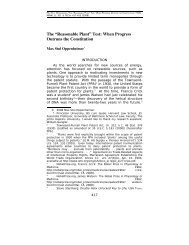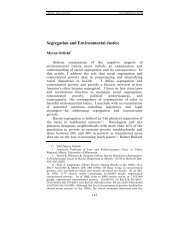An Organizational Approach to the Design of Patent Law
An Organizational Approach to the Design of Patent Law
An Organizational Approach to the Design of Patent Law
You also want an ePaper? Increase the reach of your titles
YUMPU automatically turns print PDFs into web optimized ePapers that Google loves.
6 VERTINSKY FINAL_JAD (DO NOT DELETE) 2/27/2012 2:20 PM<br />
2012] AN ORGANIZATIONAL APPROACH 233<br />
D. USING NEW INSTITUTIONAL ECONOMICS TO REORIENT PATENT<br />
POLICY<br />
The questions asked by NIE scholars, including work done<br />
on incomplete contracts, decisions about vertical integration,<br />
and <strong>the</strong>ories <strong>of</strong> <strong>the</strong> firm, arise with particular force in <strong>the</strong> context<br />
<strong>of</strong> situations where intellectual property rules come in<strong>to</strong><br />
play. 98 NIE <strong>the</strong>ories explore <strong>the</strong> impact <strong>of</strong> alternative rules,<br />
particularly property rights, in addressing <strong>the</strong> challenges <strong>of</strong> coordination,<br />
such as reducing information costs, increasing certainty<br />
in transactions, reducing <strong>the</strong> costs <strong>of</strong> bargaining and exchange,<br />
preventing free riding, and controlling negative<br />
externalities. 99 There is a growing body <strong>of</strong> <strong>the</strong>oretical and applied<br />
work in <strong>the</strong> patent literature suggesting that patent<br />
rights, along with o<strong>the</strong>r formal rules, play important roles in<br />
determining <strong>the</strong> existing structures within which innovation<br />
occurs and <strong>the</strong> performance <strong>of</strong> <strong>the</strong>se structures. 100 Applied<br />
98. See Burk, supra note 9, at 3 (“In a so-called information age, where<br />
<strong>the</strong> most important assets <strong>of</strong> firms increasingly are intangible assets, one<br />
might expect that property-based <strong>the</strong>ories <strong>of</strong> <strong>the</strong> firm would be readily applied<br />
<strong>to</strong> intellectual property.”); Kieff, supra note 9, at 330 (“The <strong>to</strong>ols NIE uses <strong>to</strong><br />
conduct comparative institutional analyses have played a central role in <strong>the</strong><br />
scholarly debate within property <strong>the</strong>ory about <strong>the</strong> shifts that occur over time<br />
among property regimes. . . . [But] <strong>the</strong> basic case for or against formal property<br />
rights for IP backed up by property rules has largely escaped <strong>the</strong> attention<br />
<strong>of</strong> <strong>the</strong> NIE literature.”) (footnote omitted); Merges, supra note 9, at 1877<br />
(2000) (“Property rights, firms, institutions, governments: all <strong>of</strong> <strong>the</strong>se are <strong>the</strong><br />
subject <strong>of</strong> extensive study by social scientists operating within <strong>the</strong> [New Institutional<br />
Economics] framework. It is time <strong>to</strong> integrate <strong>the</strong> study <strong>of</strong> IPRs in<strong>to</strong><br />
this framework.”).<br />
99. The NIE research agenda is focused on how institutions (such as <strong>the</strong><br />
laws governing property rights) matter and how <strong>the</strong>y change over time. See<br />
e.g., Coase, supra note 58.<br />
100. For important work at <strong>the</strong> intersection <strong>of</strong> patents and NIE see <strong>An</strong><strong>to</strong>n<br />
& Yao, supra note 41, at 190–192 (analyzing <strong>the</strong> ability <strong>of</strong> independent inven<strong>to</strong>rs<br />
<strong>to</strong> negotiate with firms in <strong>the</strong> absence <strong>of</strong> patent protection); Barnett, Intellectual<br />
Property as a <strong>Law</strong> <strong>of</strong> Organization, supra note 9, at 3; Jonathan M.<br />
Barnett, Sharing in <strong>the</strong> Shadow <strong>of</strong> Property: Rational Cooperation in Innovation<br />
Markets 1 (Univ. S. Cal. Center in <strong>Law</strong>, Econ., & Org. Research Paper No.<br />
C08–22, 2008), available at http://ssrn.com/abstract=1287283 (<strong>to</strong> access article,<br />
select One-Click Download) (explaining that sharing <strong>of</strong> intellectual property<br />
can lower transaction costs, but requires a framework <strong>to</strong> operate within);<br />
Burk, supra note 9, at 3 (2004) (examining intellectual property laws in light<br />
<strong>of</strong> <strong>the</strong>ories <strong>of</strong> <strong>the</strong> firm); John F. Duffy, The Marginal Cost Controversy in Intellectual<br />
Property, 71 U. CHI. L. REV. 37, 37–39 (2004) (drawing analogies between<br />
IP and public utility regulation, and revisiting Coase’s critique <strong>of</strong> proposals<br />
for public subsidies <strong>to</strong> reduce costs <strong>to</strong> marginal cost in <strong>the</strong> context <strong>of</strong><br />
IP); Gallini & Winter, supra note 41, at 238 (exploring <strong>the</strong> role <strong>of</strong> patents in<br />
opening markets for trade in technological innovation); Paul J. Heald, Trans-






